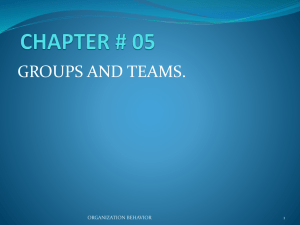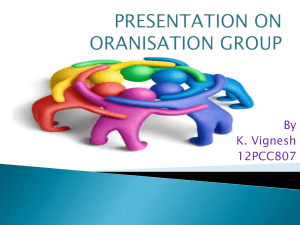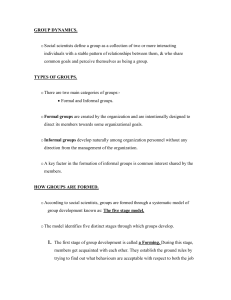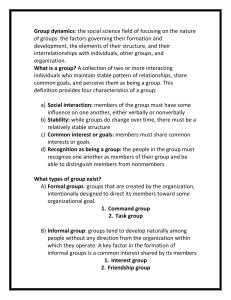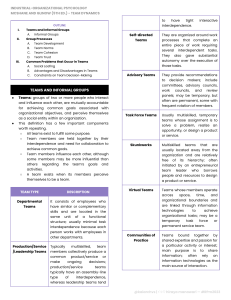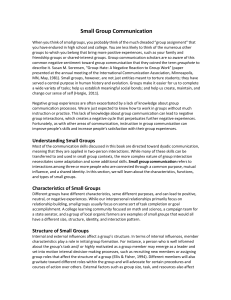group
advertisement
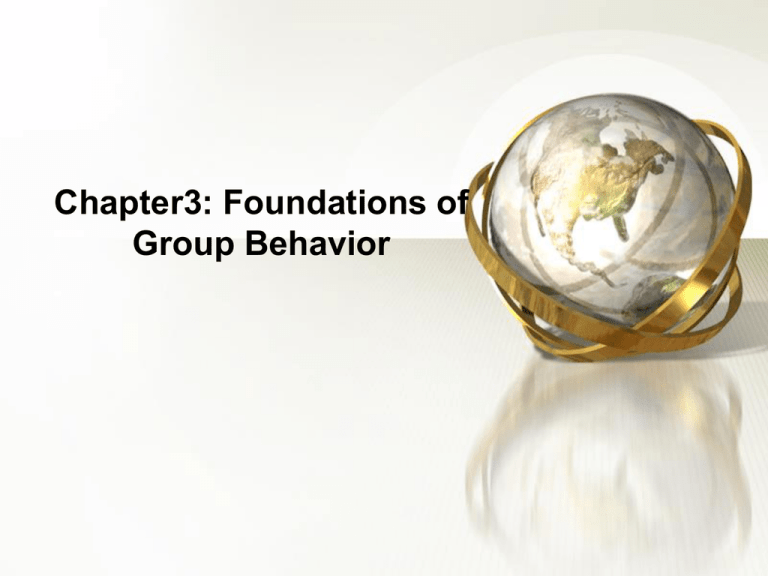
Chapter3: Foundations of Group Behavior Definition of a Group A group is defined as two or more individuals, interacting and interdependent, who have come together to achieve particular objectives. Various Types of Groups Formal groups Command groups Task groups Informal Groups Friendship groups Interest groups Small groups Large groups Primary groups Secondary groups Coalitions Membership groups Formal Groups These groups are formed by the organization to carry out specific tasks. It includes two types: Command group Task groups Informal Groups Informal groups are formed by the employees themselves. They are not formally structured. They are of two types: Friendship groups Interest groups Formal / Informal Group Other types Include Small groups: Only a few members. Face-to-face interaction and better communication is possible. Large groups: Members is very high. Personal interaction is not possible. Stages of Group Development The five-Stage Model: Adjourning/Mourning Completion, ending or evolution Performing Achieving the purpose Norming Agreeing purpose and conduct Storming Resolving differences Forming Initial meeting together Composition of a Group Most group activities require a variety of skills and knowledge. Research studies show that heterogeneous groups are likely to perform more effectively. Cohesion of group Degree to which group members are attracted to each other and are motivated to stay in the group. Managerial Implication – To increase cohesion of groups: • Make the group smaller. • Encourage agreement with group goals. • Increase time members spend together. • Increase group status and admission difficulty. • Stimulate competition with other groups. • Give rewards to the group, not individuals. Factors affecting the group behavior • • • • • • • • • Norms Roles Size of groups Management philosophy Internal environment of the organization The external environment Group behavior The type of leadership approach Different level of perception and understanding Norms: Acceptable standards of behaviour within a group that are shared by the group’s members. Roles: Set of behavior pattern which an individual occupying a certain position in society. Size of a Group The size of a group affects the group’s overall behavior, but the effect depends on the dependent variables: Smaller groups are faster at completing tasks than are larger ones. Definition of Work Teams A small number of people with complementary skills who are committed to a common purpose, common performance goals, and an approach for which they hold themselves mutually accountable”. -G. Moorhead and R.W. Griffin Benefits of Work Teams • • • • Enhanced performance Employee benefits Reduced costs Organizational enhancements Team groups determinants Size of work teams Abilities of members Allocation of work roles realistic performance goals Good leadership and effective structure Teams and Total Quality Management TQM means process improvement and employee involvement is the key to process improvement. Teams and Workforce Diversity Diversified teams provide unique and innovative solutions, but at the same time, they are cohesive.


